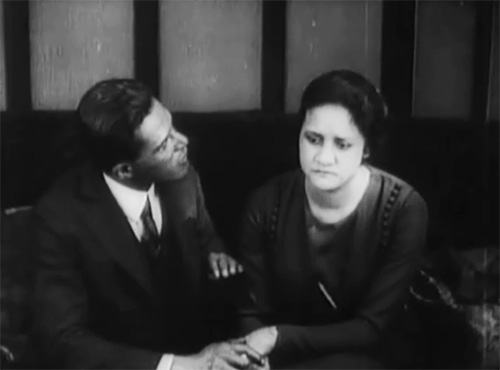Introduction
| Fighting Race Calumny Within Our Gates (full–length film) A Review of Within Our Gates Acknowledgments |
|
On January 1, 1915, The Birth of a Nation, under its preview title, The Clansman, premiered at the Loring Opera House in Riverside, California. The Riverside Daily Press and The Riverside Enterprise reported enthusiastic audiences—“No photo-play of its proportions has been so enthusiastically applauded in this city.” The film officially opened February 8, in Los Angeles, and was privately shown to President Woodrow Wilson on February 18, making it the first film screened at the White House.
Despite the fanfare, it was immediately controversial. Among early challengers was the NAACP, whose individual chapters mobilized in their respective local film markets, sometimes succeeding in preventing the film’s release or having some of its most overtly racist scenes deleted. The NAACP’s actions were chronicled monthly in The Crisis, which also published opinions against the film. The May and June 1915 issues of the journal published “Fighting Race Calumny,” a detailed account of the specific actions taken against the film, beginning in February 12-26 (1915):
We are advised by our Los Angeles Branch that “The Birth of a Nation,” a picture play founded on Dixon’s “Clansman,” is running in that city and that the branch has been unable to suppress the play because it has the approval of the National Board of Censorship, located in New York.
Protests against The Birth of a Nation gained momentum in Boston, where, in early May 1915, there was a 2,500-person “mass meeting” at Tremont Temple, as well as one on Boston Common. The November 1915 issue of The Crisis also points to a pamphlet put out by the Boston branch of the NAACP:
We go to press too early to include more than the mention of a report just received from Mr. Wilson describing the valuable work being done by our Boston Branch which has recently published a pamphlet entitled “Fighting a Vicious Film” which is distributing broadcast throughout the country. The pamphlet includes letters, speeches and evidence used in the protests the Branch made against the film “The Birth of a Nation.”
Around this time, “race movies,” those produced specifically for African American audiences, began to flourish. Ebony Film Company, in 1915, became the first film company to focus solely on producing race movies. Noble Johnson founded the first African American–owned film company, The Lincoln Motion Picture Company, in 1916. In 1919, Oscar Micheaux started Micheaux Book & Film Company, and he became one of the most prolific African American filmmakers, directing over forty films with predominantly African American casts for African American audiences.
Micheaux’s first feature-length film, The Homesteaders, premiered in 1919. Within Our Gates premiered the following year. The film was an attempt, in part, to counter the racist portrayal of African Americans in The Birth of a Nation. For instance, The Birth of a Nation’s infamous “Gus scene” portrayed a white woman throwing herself off a cliff rather than be raped by an African American man. Within Our Gates challenges this, when, in the last twenty minutes of the film, a white man attempts to rape Sylvia, the film’s African American protagonist.
But, as Darvarian L. Baldwin argues in his 2007 book, Chicago’s New Negroes: Modernity, The Great Migration, and Black Urban Life:
More than a simple response to The Birth of a Nation, this film was part of the larger “Grand Narrative” of race-specific concerns drawing together the issues of lynching, rape, miscegenation, and migration that were already part of a larger black public sphere conversation.
Within Our Gates’ ending is further complicated by the would-be rapist’s realization, from a scar on Sylvia’s chest, that she is his daughter. The scene is part of a larger flashback, as Sylvia's love interest, Dr. Vivian, learns about her past, including the lynching of her adopted parents by a white mob. The film ends with Dr. Vivian’s acceptance of Sylvia and her history.
 |
Within Our Gates took two months to get past the Censor Board in Chicago and premiered on January 29, 1920, less than a year after the city’s 1919 race riots. The delay in release, promoted in the film’s advertising, generated greater public interest, and Within Our Gates was successful in Chicago and other markets. A January 24 review of the film in The Chicago Defender concludes:
People interested in the welfare of the Race cannot afford to miss seeing this great production, and, remember, it tells it all.
